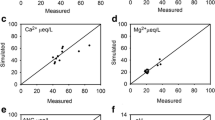Abstract
The Integrated Lake-Watershed Acidification Study (ILWAS) model was developed to predict changes in surface water acidity given changes in the acidity of precipitation and dry deposition. The model routes precipitation through the forest canopy, soil horizons, streams and lakes using mass balance concepts and equations which relate flow to hydraulic gradients. The physical-chemical processes which change the acid-base characteristics of the water are simulated by rate (kinetic) and equilibrium expressions and include mass transfers between gas, liquid and solid phases. The aqueous constituents simulated include: pH, alkalinity, the major cations (Ca2+, Mg2+, K+, Na+, and NH4 +) and anions (SO 2-4 , NO -3 , Cl-, F-), monomeric Al and its inorganic and organic complexes, organic acid analogues and dissolved inorganic carbon (CT). Since free hydrogen ion (H+) (and hence pH) is not conserved, its concentration is derived from the solution alkalinity and the total concentrations of inorganic C, organic acid, and monomeric Al.
The ILWAS model has been used to predict changes in the acidity of Woods Lake (typical lake pH 4.5 to 5.0) and Panther Lake (typical lake pH 6 to 7) given reductions in total atmospheric S loads. The two basins are located within 30 km of each other in the Adirondack Mountains and receive similar acidic deposition. The response to a halving in the total atmospheric S load was basin-specific: In Panther Lake, little pH change occurred even 12 yr after the load reduction; in Woods Lake, the change was considerably larger.
Hypothesis testing with the model has shown that the routing of water through soils (shallow versus deep flow) largely determines the extent to which incident precipitation is neutralized. Analysis of the two lake basins using the model and field data showed the watersheds to be net suppliers of base to the through-flowing water, although internal watershed production of strong acidity did occur. This internal production of acidity was approximately two-thirds the amount of the atmospheric load.
Access this chapter
Tax calculation will be finalised at checkout
Purchases are for personal use only
Preview
Unable to display preview. Download preview PDF.
Similar content being viewed by others
References
Chen, C. W., Gherini, S. A., and Goldstein, R. A.: 1979, ‘Modeling the Lake Acidification Process’, in Proceedings of Workshop on Ecological Effects and Acid Precipitation, Central Electricity Research Laboratory, United Kingdom. Section 5, pp. 1–26.
Chen, C. W., Gherini, S. A., Hudson, R. J. M., and Dean, J. D.: 1983, The Integrated Lake-Watershed Acidification Study: Volume 1, Model Principles and Application Procedures. Electric Power Research Institute, Research Project 1109–5, EA-3221.
Gran, G.: 1952, Analyst 77, 661.
Goldstein, R. A., Gherini, S. A., Chen, C. W., Mok, L., and Hudson, R. J. M.: 1984, Phil. Trans. R. Soc. Lond. B305, 409.
Johannes, A. H., Altwicker, E. R., and Clesceri, N. L.: 1985, Water, Air, and Soil Pollut. 26, 339 (this issue).
Newton, R. and April, R.: 1981, personal communication.
Schofield, C.: 1986, Water, Air, and Soil Pollut. 26, 403.
April, R. and Newton, R.: 1985, Water, Air, and Soil Pollut. 26, 373 (this issue).
Stumm, W. and Morgan, J. J.: 1970, Aquatic Chemistry — An Introduction Emphasizing Chemical Equilibria in Natural Waters, John Wiley and Sons, Inc. pp. 1–583.
Valentini, Joy.: 1985, ILWAS Data Base, Tetra Tech, Inc., Lafayette, CA.
Author information
Authors and Affiliations
Rights and permissions
Copyright information
© 1985 D. Reidel Publishing Company
About this chapter
Cite this chapter
Gherini, S.A., Mok, L., Hudson, R.J.M., Davis, G.F., Chen, C.W., Goldstein, R.A. (1985). The ILWAS Model: Formulation and Application. In: Integrated Lake-Watershed Acidification. Springer, Dordrecht. https://doi.org/10.1007/978-94-009-5498-4_7
Download citation
DOI: https://doi.org/10.1007/978-94-009-5498-4_7
Publisher Name: Springer, Dordrecht
Print ISBN: 978-94-010-8926-5
Online ISBN: 978-94-009-5498-4
eBook Packages: Springer Book Archive




